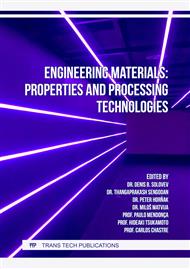[1]
Yu.S. Urzhumtsev, V.N. Bulmanis, Features of creation and research of structures of reinforced plastics for cold climate conditions, Composite materials and their use in the national economy, VI All-Union Conf., Tashkent, 1986, pp.36-41.
Google Scholar
[2]
Modern problems of construction and life support: safety, quality, power - and resource-saving: the collection of articles of the IV All-Russian scientific and practical conference devoted to the 60 anniversary of Technical institute of the North eastern federal university of M.K. Ammosov. Yakutsk, October 27-28, 2016 under the editorship of associate Savvina A.E., Kuzmin S.A., Krasilnikov D.A., Petrova D.S., Sleptsova M.E., Hon Z.N., Nikitina T. I., Nikolaeva A.A., Everstova A.A. The research of durability of constructional materials modified by polymeric Silor-ultra additive, SECTION 3, CONSTRUCTION MATERIALS AND PRODUCTS, p.228
DOI: 10.26787/nydha-2226-7425-2018-20-11-98-101
Google Scholar
[3]
S.A. Kuzmin, D.A. Krasilnikov, E.A. Ruban, The collection of the All - Russian conference with the international participation devoted to the 70 anniversary of professor-mechanic Dr.Sci.Tech. A.V. Lyglayev "Cold resistance. New technologies for the equipment and a design of the North and the Arctic" the RESEARCH of DURABILITY of M-200, MODIFIED POLIMER CONCRETE "SILOR-ULTRA" ADDITIVE, Yakutsk, 2016.
Google Scholar
[4]
S.A. Kuzmin, A.A. Argunova, D.A. Krasilnikov, Z.V. Emelianova, Research of Durability and Structure of the Heavy Concrete Modified by Polymeric Impregnation in the Frigid Climate, Materials Science Forum. Vol. 945 (2019) 250-256.
DOI: 10.4028/www.scientific.net/msf.945.250
Google Scholar
[5]
S.A. Kuzmin, A.D. Egorova, D.A. Krasilnikov, Z.V. Emelianova, Durability of construction materials modified by polymeric additives, Procedia Structural Integrity. Vol. 20 (2019) 278-283
DOI: 10.1016/j.prostr.2019.12.152
Google Scholar
[6]
A. Egorova, D. Krasilnikov, V. Gavrilyev, V. Kirillin, M. Kychkin, Wood concrete on the basis of Portland cement with silor-ultra additive, Norwegian Journal of development of the International Science, Oslo, Norway. 27 (2019) 63-66.
Google Scholar
[7]
M. Kanematsu, I. Maruyama, T. Noguchi, H. Iikura, N. Tsuchiya, Quantification of water penetration into concrete through cracks by neutron radiography, Nucl Instrum Methods Phys Res A. 605(2009) 154-158.
DOI: 10.1016/j.nima.2009.01.206
Google Scholar
[8]
V. Picandet, A. Khelidj, H. Bellegou, Crack effects on gas and water permeability of concretes. Cem Concr Res. 39 (2009) 537-547.
DOI: 10.1016/j.cemconres.2009.03.009
Google Scholar
[9]
Li, Wenting, Jiang, Zhengwu, Yang, Zhenghong, Self-Healing Efficiency of Cementitious Materials Containing Microcapsules Filled with Healing Adhesive: Mechanical Restoration and Healing Process Monitored by Water Absorption, PLOS ONE. Т: 8 (2013) 11.
DOI: 10.1371/journal.pone.0081616
Google Scholar
[10]
S.F. Korenkova, S.Ya. Karasyova, E.M. Rudakova, Polymer concrete on the basis of styrene, Bash. chemical j. No. 4 (2012) 230-232.
Google Scholar
[11]
B. Gerard, H.W. Reinhardt, B. Breysse, Measured transport in cracked concrete, In: HW Reinhardt. RILEM Report, penetration and permeability of concrete. 16 (1997) 265-324.
Google Scholar
[12]
Mehta PK, Durability-Critical issues for the future. Concr Int 19. (1997) 1-12.
Google Scholar
[13]
Mehta PK, Concrete technology for sustainable development. Concr Int. 21 (1999) 47-53.
Google Scholar
[14]
ACI Committee 224 Causes, evaluation and repair of cracks in concrete structures, ACI committee report: Concrete repair manual 1R-93, 1993.
DOI: 10.14359/18555
Google Scholar
[15]
K.J. Wang, D.C. Jansen, S.P. Shah, A.F. Karr, Permeability study of cracked concrete, Cem Concr Res 27, 381–393.
Google Scholar


